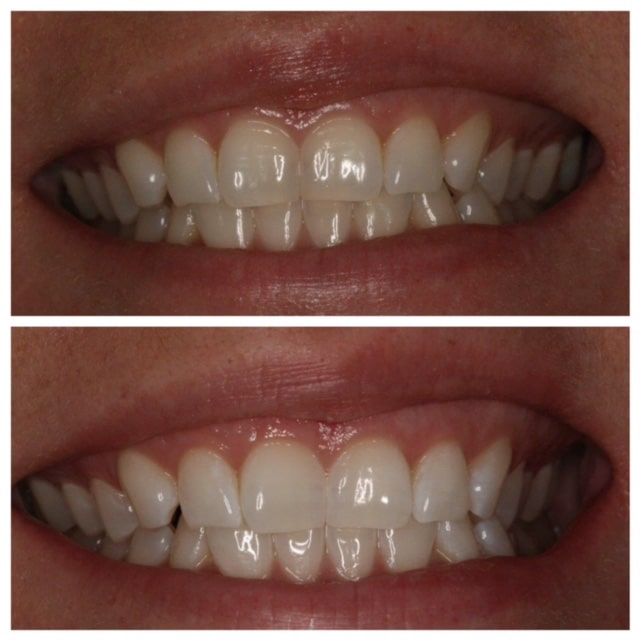 Many teeth whitening systems and products are available, including whitening toothpaste, over-the-counter gels, rinses, strips, trays, and whitening products obtained from a dentist.
Many teeth whitening systems and products are available, including whitening toothpaste, over-the-counter gels, rinses, strips, trays, and whitening products obtained from a dentist.
Teeth whitening is ideal for people who have healthy, unrestored teeth (no fillings) and gums. Individuals with yellow tones to their teeth respond best. But this cosmetic procedure is not recommended for everyone.
Find out if teeth whitening is right for you.
What are the Different Types of Whitening Toothpaste?
All kinds of toothpaste help remove surface stains because they contain mild abrasives. Some whitening toothpaste contains gentle polishing or chemical agents that provide additional stain removal effectiveness. Whitening toothpaste can help remove surface stains only and do not contain bleach; over-the-counter and professional whitening products contain carbamide peroxide or hydrogen peroxide that helps lighten the color deep in the tooth. Whitening toothpaste can lighten the tooth’s color by about one shade. In contrast, light-activated whitening conducted in your dentist’s office can make your teeth three to eight shades lighter.
Over-the-Counter Whitening Strips and Gels
Whitening gels are clear, peroxide-based gels applied with a small brush directly to the surface of your teeth. Instructions generally call for twice a day application for 14 days. Initial results are seen in a few days and final results are sustained for about four months.
Whitening strips are very thin, virtually invisible strips that are coated with a peroxide-based whitening gel. The strips are applied twice daily for 30 minutes for 14 days. Initial results are seen in a few days and final results are sustained for about four months.
Whitening Rinses
Among the newest whitening products available are whitening rinses. Like most mouthwashes, they freshen breath and help reduce dental plaque and gum disease. But these products also include ingredients, such as hydrogen peroxide, which whiten teeth. Manufacturers say it may take 12 weeks to see results. You just swish them around in your mouth for 60 seconds twice a day before brushing your teeth. However, some experts say that rinses may not be as effective as other over-the-counter whitening products. Because a whitening rinse is only in contact with the teeth for such a short time — just two minutes a day compared to 30 minutes for many strips — it may have less of an effect.
Tray-Based Tooth Whiteners
Tray-based tooth whitening systems, purchased either over-the-counter or from a dentist, involve filling a mouth guard-like tray with a gel whitening solution — which contains a peroxide-bleaching agent. The tray is worn for a period of time, generally from a couple of hours a day to every day during the night for up to four weeks and even longer (depending on the degree of discoloration and desired level of whitening).
In-Office Whitening
In-office bleaching provides the quickest way to whiten teeth. With in-office bleaching, the whitening product is applied directly to the teeth. These products can be used in combination with heat, a special light, and/or a laser. Results are seen in only one, 30- to 60-minute treatment. But to achieve dramatic results, several appointments are usually needed. However, with in-office bleaching, dramatic results can be seen after the first treatment. This type of whitening is also the most expensive technique.
How Long Do Teeth Whitening Effects Last?
Teeth whitening is not permanent. People who expose their teeth to foods and beverages that cause staining may see the whiteness start to fade in as little as one month. Those who avoid foods and beverages that stain may be able to wait one year or longer before another whitening treatment or touch-up is needed.
The degree of whiteness will vary from individual to individual depending on the condition of the teeth, the level of staining, and the type of bleaching system used.
Patient Testimonial
“The best people you’ll ever meet all in one office. Extremely professional, kind and intelligent. If I ever move, I’d have to fly back in for my appointments.” – Krenar J.
Professional vs. At Home Whitening
There are differences between whitening teeth at home and having them bleached in a dentist’s office, including:
Strength of bleaching agent
Over-the-counter products and dentist-supervised at-home products usually contain a lower strength bleaching agent, with about a 10% to 22% carbamide peroxide content, which is equivalent to about 3% hydrogen peroxide. In-office, professionally applied tooth whitening products contain hydrogen peroxide in concentrations ranging from 15% to 43%.
Mouthpiece trays
With dentist-supervised at-home bleaching products, your dentist will take an impression of your teeth and make a mouthpiece tray that is customized to exactly fit your teeth. This customization allows for maximum contact between the whitening gel, which is applied to the mouthpiece tray, and the teeth. A custom-made tray also minimizes the gel’s contact with gum tissue. Over-the-counter whitening products also contain a mouthpiece tray, but the “one-size-fits-all” approach means that the fit will not be exact. Ill-fitting trays can irritate the gum and soft tissue by allowing more bleaching gel to seep onto these tissues. With in-office procedures, the bleaching agent is applied directly to the teeth.
Additional protective measures
In the office setting, your dentist will apply either a gel to the gum tissue or use a rubber shield (which slides over the teeth) prior to treatment to protect your gums and oral cavities from the effects of the bleaching. Over-the-counter products don’t provide these extra protective measures.
Costs
Over-the-counter bleaching systems are the least expensive option, with in-office whitening being the costliest.
Supervised vs. unsupervised process
Dentist-supervised at-home bleaching and in-office treatments offer additional benefits compared with over-the-counter procedures. First, your dentist can perform an oral exam and consider your complete medical history, which can be helpful in determining if bleaching is an appropriate course of treatment based on the type and extent of stains, and the number and location of restorations. Your dentist can then better match the type of stain with the best treatment, if appropriate, to lighten those stains. With dentist-supervised bleaching procedures, your dentist will likely want to see you a couple of times to ensure you are following directions, to make sure the customized tray is fitting properly, to inspect the gums for signs of irritation, and to generally check on how the teeth whitening process is proceeding. With over-the-counter bleaching products, you are on your own.
Schedule a Consultation
To schedule a consultation or to learn more about our Teeth Whitening services, contact us today at (203) 746-1200. Our practice serves New Fairfield, CT, and the surrounding areas.
